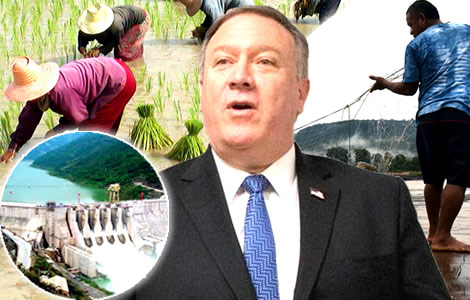Last year at the height of the drought crisis, the Thai government reached out to Beijing and called in the Chinese ambassador to discuss conditions in the Mekong river basin and the effects of climate change. While the low water levels then and the scarcity of water now may be more to do with the lack of precipitation heightened by the El Niño effect, many in the northern provinces and environmentalists are concerned about the real impact of dam building upriver on the Mekong where China has put in place at least 11 mega-dams that appear to be able to switch on and off the flow of the once-mighty but now tamed Mekong river.
There have been reports of profiteering and rising rice prices in the last week as the current drought in the north of Thailand continues. The situation has seen some farmers holding on to rice supplies and middlemen stockpiling the crop. However, experts with the Mekong River Commission expect the situation to alleviate from the middle of January with wetter conditions expected. The price of rice is also still well within median levels although it has risen significantly since November. Since last year’s drought and record low levels of water within the Mekong basin, there is concern being expressed for the health of the river and the threat from Chinese dam building. One of those who highlighted this concern in August was US Secretary of State, Mike Pompeo, on his visit to Bangkok. Northern provinces have now been told to expect as much as a 1-metre drop in water levels in certain provinces from January 2nd to 19th because of testing on a huge upriver dam project in China’s Yunnan province.

Concerns are developing in the north of Thailand where the price of rice or the 5% Broken Rice Price has shot up by 6% since November due to drought concerns and is being quoted at $445. Long considered Thailand’s hidden secret because of its ability to produce an abundance of rice, the basin of the Mekong River has been experiencing problems in recent times.
This week, with reports of large areas of land from 600,000 to 960,000 rai which may not able to be cultivated in the short term due to a severe drought similar to last year, there is evidence of profiteering with farmers and producers holding on their rice output as the price rises.
Plentiful rains in August saved the 2019 rice harvest
Last year, the year began with a drought which severely impacted farmers in Thailand’s northern region but a plentiful supply of rain in August caused a recovery in the harvest.
It still left the land with a shorter monsoon period and significantly lower rainfall. This is being felt now. The price of rice, while it has varied in recent years, is still well within its median price range although exports of Thai rice last year were down significantly. This was attributed to a higher-priced baht.
The price of rice in Thailand has a significant impact on the lives of poorer Thais as the food is an essential staple of Thai cuisine eaten by the population throughout the country in rural and urban settings alike.
Rice has become a focus on speculation
In the last week alone, the price for the essential crop could be seen to be moving up sharply. This can be seen from Thailand’s benchmark 5 per cent broken rice price which rose from a range of ฿392 to ฿420 last week to $424 to $445 this week.
There are also reports of speculative buying within the market. ‘There are concerns that the ongoing drought could hurt future supply so there is speculative buying and stockpiling by some mills and exporters, which has driven up the prices,’ this was according to an experienced rice trader in the Thai capital this week.
Up 1 million rai of land out of production because of drought conditions for the start of the year
In early November, the government which has been closely monitoring the situation warned that up to 960,000 hectares within the Chao Phraya River basin would not have enough water to grow the crop in the early part of the year. The Chao Phraya and Mekong rivers combined are the basis of Thailand’s vast agricultural economy.
El Niño effect is playing a part in the problem
The reasons for the problem are somewhat varied. For a start, it is down to the weather. While some would argue that this is an impact of climate change, most scientists and people close to the management of water on the Mekong such as those working with the Mekong River Commission will certainly identify a strong El Niño effect both last year and this year.
Lower rainfall and faster evaporation due to hot weather caused by El Niño in 2019
Experts working with the commission have suggested that the area has suffered from lower rainfall amounts with the Monsoon season beginning late and ending early. They also explain that the El Niño effect produced abnormally high temperatures which caused water to evaporate faster. In 2019, it is reported that the rains began two weeks later than at the end of May which is normal and ended three weeks earlier than October.
‘This year’s prolonged dry weather conditions can possibly adversely impact agricultural and crop production. The issue of water shortages for consumption could also come into play as the drought persists,’ predicted Dr Lam Hung Son who works with the Mekong River Commission speculating on drought patterns this year.
Southeast Asian countries came together to sign the 1995 Agreement on the Cooperation for the Sustainable Development of the Mekong River Basin. However, China has persistently refused to be part of that agreement which includes Laos, Vietnam, Cambodia and Thailand.
Mekong River Commission predicted drought from December to January 2020 but then wetter conditions
In fact, this body last year had already predicted drought conditions in the Mekong affecting Thailand’s northern provinces which they said would worsen from December until early January when matters should improve somewhat. This, they explained would be due to a lack of raim across 12 of Thailand’s northern provinces from Chiang Mai to Sisaket.
The experts predicted that the drought will weaken from the second week in January 2020 when wetter conditions are expected.
Problems of 2019 extending into 2020, Mekong River saw its lowest level in 60 years last July
However, there is concern that the problems from 2019 impacting the valuable rice crop in Thailand appear to be extending into 2020. There is also concern about the state of the Mekong River which in 2019 saw its lowest levels in 60 years.
Anxiety over Chinese dam building
A significant part of this anxiety is due to China and its huge dam-building programme on the upper stretches of the Mekong River.
On a visit to Bangkok, last August, US Secretary of State Mike Pompeo addressed what may be a more significant and pressing problem than had previously been thought when he said: ‘The river is at its lowest levels in a decade, a problem linked to China’s decision to shut off water upstream.’
A new Chinese threat and weapon
There is now a growing acceptance among experts that the situation on the Mekong River could well emerge as a bigger flashpoint between China and Southeast Asian nations than the quarrel over the South China Sea.
In 2017, an independent expert, Eugene Chow described the situation that now exists. He said it was a Chinese weapon hidden in ‘plain sight’ that would allow the emerging superpower to ‘hold a quarter of the world’s population hostage without firing a single shot.’
Thai water agency tells farmers to expect a drop in Mekong River water level due to Chinese testing
This week, the Thai Office of National Water Resources announced that even existing water levels already challenged by drought would drop in the provinces of Chaing Rai, Nakhon Phanom, Nong Khai, Mukdahan, Bueng Kan, Amnat Charoen and Ubon Ratchathani when testing begins on the Chinese $1.676 billion Jinghong dam, a huge 1,750 MW power station being developed in Yunnan province.
It is only one of many which are now using the water flow of the Mekong River with significant and unknown side effects on the river downstream and the environment.
Up to 1-metre drop in water levels from January 2nd to 19th on the Mekong in northern provinces
For now, the Thai government statement outlines that water levels on the Mekong will be down 40-60 centimetres during the initial stages of the tests being carried out in certain provinces at different times. Farmers have been told to expect to see lower water levels from January 2nd to the 5th.
They have also been told that at the height of the tests to expect a further 30-centimetre drop meaning that in some areas, the river will have dropped by nearly a metre.
This guidance to farmers and users of the river was issued by the Secretary-General of the Office of National Water Resources, Somkiat Prajamwong.
Release of water by Chinese authorities last year only confirmed the extent of control of the river
The announcement is bound to further disturb farmers and those in Thailand dependant on the Mekong river as a basis to grow rice and even those involved in fisheries.
It is similar to an announcement by the Chinese government at the height of the problem last year that would release more water into the river. This served only to confirm that something fundamental had changed and that the river is now substantially controlled by the Chinese dams upriver.
However, most experts still believe that while this situation is cause for concern, the real problem causing the drought conditions and lower water reserves is still primarily a lack of rain.
However, this does not preclude the controlled water levels in the Mekong and lack of water flow from upstream from being a contributing factor to what has become a problematic environment with drought conditions and low reservoir levels.
Warning of bleak outlook going into 2020 for water management efforts with low reservoir levels
It comes at a time in Thailand where bodies charged with overseeing the water supply are warning of a dire situation. Thailand’s Hydro-Informatics Institute has confirmed that reservoirs across Thailand are at a critical level due to lack of rainfall.
The expert body points to a rainfall level in 2019 which had been 18% below average and this effect has been most pronounced in the northern provinces where rainfall was 24% below average with southern provinces also below average.
A lack of rainfall and freshwater volume is also seen in higher levels of saltwater encroachment into the system meaning higher salt levels in the water posing a challenge for tap water production.
‘China is completely in control of the water’
Last year in July, fishermen in Nakhon Phanom reported the lowest water levels on the Mekong that anyone alive could remember. While some experts pointed to lower rainfall, many locals and experts blamed the dam-building upstream by Chinese authorities.
A report by Reuters quoted Premrudee Deoruong of the Laos Dam Investment Monitor, an environmental group that monitors the river: ‘Now China is completely in control of the water. From now on, the concern is that the water will be controlled by the dam builders.’
River depth last July was 1.5 metres when it should be 8 metres as fishermen gave up on big fish
At the end of July 2019, the Mekong River in the area was 1.5 metres in depth when it should normally be 8 metres. Fishermen who had worked on the river for a lifetime were reported to have changed their fishing nets in recent times as the river no longer supported large fish.
For those making their living from the water, this meant smaller net sizes, more work and smaller income.
‘What I have seen this year has never happened before,’ said one fisherman named as Sun Prompakdee. The 60-year-old fisherman from Ban Nong Chang village had been fishing the river for all his life. ‘Now we only get small fish, there are no big fish when the water is this low,’ he said.
Significantly lower rainfall last year
Again the rainfall last year was, at that point, 40% below normal and no one is quite certain which is the most decisive factor in lowering water levels on the powerful Mekong River.
China has now constructed 11 huge dams to provide hydropower to generate massive 21,300 MW of electricity on the river.
Thai government reached out to Beijing through the Chinese ambassador and action was taken
At the height of the crisis, last year, the Thai government reached out to Chinese authorities. At the time, the Chinese ambassador was invited to discuss the drought in the Mekong River basin and climate change. This prompted a positive response from Beijing which later announced a release of water into the river.
Confirmed the worst fears of observes and environmentalists as it demonstrated Chinese power
Ironically, this development only confirmed the worst fears of environmentalists who have long expressed concern with the continuous use and deployment of the Mekong upriver for generating electricity by Chinese authorities.
They warn of irreversible change to the ecosystem of the river and its natural balance which they fear may come with a long list of unintended consequences for the river and the countries downstream.
‘It is using the river for only one use, hydropower and the other users are being marginalized,’ revealed Pianporn Deetes of the International Rivers group, a worldwide organisation which promotes the health of powerful international rivers and their watersheds across the planet.
Further reading:
US Secretary of State in Bangkok heralds closer ties with ASEAN bloc – good news for Thailand
Market conditions for Honda motorbikes may be a signpost for a stalling Thai economy in 2019


















